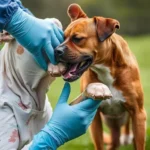
Introduction
As a loving pet owner, ensuring your dog’s health and well-being is a top priority. One often overlooked aspect of dog health care is the impact of insects on our furry friends. Insects like fleas, ticks, and mosquitoes can cause significant harm to dogs, leading to discomfort, disease, and even serious health complications. Understanding how to protect your dog from insects is crucial in maintaining their health and happiness.
In this comprehensive guide, we will delve into the common insect threats to dogs, effective preventative measures, and what to do if your pet becomes infested. By implementing these strategies, you can create a safer environment for your dog and promote their overall health.
Understanding Insect Threats to Dogs
Common Insects that Affect Dogs
Insects can pose a variety of threats to dogs, leading to health issues that may require medical attention. Here are the most common insects that you need to be aware of:
-
Fleas: These tiny parasites are notorious for causing itching and irritation. Fleas have a complex life cycle, consisting of eggs, larvae, pupae, and adults. A single female flea can lay up to 50 eggs per day, leading to rapid infestations. In addition to causing discomfort, fleas can transmit tapeworms and other diseases.
-
Ticks: Ticks are blood-sucking parasites that attach themselves to dogs and can transmit a range of tick-borne diseases, such as Lyme disease, Rocky Mountain spotted fever, and ehrlichiosis. Common types of ticks that affect dogs include the deer tick, brown dog tick, and American dog tick. Understanding the risks associated with tick bites is essential for your dog’s health.
-
Mosquitoes: While often overlooked, mosquitoes can also pose a serious threat to dogs. They are carriers of heartworm, a potentially fatal disease that affects the heart and lungs of infected animals. A single bite from an infected mosquito can lead to severe health complications.
-
Other Insects: Other insects such as flies and mites can also affect dogs. Flies can cause irritation and lead to infections, while mites can cause conditions such as mange, resulting in severe skin issues.
Symptoms of Insect Infestation
Recognizing the signs of insect infestations early can help you take action before your dog suffers too much discomfort. Here are some common symptoms to watch for:
-
Physical Signs of Fleas and Ticks: Excessive scratching, biting at the skin, hair loss, and visible fleas or ticks on the fur are all indicators of infestation. Dogs may also develop hot spots or skin infections as a result of constant scratching.
-
Mosquito Bite Reactions: Dogs may experience swelling, redness, and itching at the site of a mosquito bite. Severe reactions can lead to more serious conditions, including allergic reactions.
-
Behavioral Changes: Discomfort from insect bites can lead to changes in behavior. If your dog seems more irritable, restless, or withdrawn than usual, it may be a sign of discomfort from insect-related issues.
Preventative Measures
Regular Grooming
One of the most effective ways to protect your dog from insects is through regular grooming.
-
Brushing: Frequent brushing helps to remove loose hair and debris, reducing the likelihood of fleas and ticks finding a place to hide.
-
Bathing: Regular baths with flea and tick shampoos can help eliminate existing pests and prevent new infestations. Look for shampoos specifically designed for insect control.
Safe and Effective Insect Repellents
There are various insect repellent options available, and choosing the right one is crucial for your dog’s safety.
-
Topical Treatments: Spot-on treatments are popular for flea and tick prevention. These products are applied directly to your dog’s skin and provide prolonged protection.
-
Oral Medications: Some owners prefer oral medications, which can be effective but may come with side effects. Consult your veterinarian to determine the best option for your dog.
-
Natural Repellents: Essential oils and herbal remedies can offer a more natural approach to insect repellent. However, always consult your veterinarian before using these products, as some essential oils can be toxic to pets.
Vaccination and Veterinary Care
Regular veterinary visits are essential for maintaining your dog’s health and protecting them from insect-borne diseases.
-
Vaccinations: Ensure your dog is up-to-date on vaccinations that protect against diseases transmitted by insects, such as Lyme disease and heartworm.
-
Regular Check-ups: Routine veterinary check-ups can help identify any health issues early on, including those related to insect infestations.
-
Heartworm Prevention: Administering heartworm prevention medications as recommended by your veterinarian is crucial for protecting your dog from this deadly disease.
Creating a Safe Environment
Indoor Prevention Strategies
Keeping your home clean and insect-free is a fundamental aspect of protecting your dog.
-
Cleaning: Regularly vacuuming carpets and upholstery helps to remove fleas and their eggs from your home. Wash your dog’s bedding frequently to eliminate any hiding pests.
-
Insect Screens: Installing screens on windows and doors can prevent insects from entering your home.
-
Indoor Repellents: Consider using indoor insect repellents and traps to deter pests from lingering in your living space.
Outdoor Safety Measures
Outdoor environments can expose dogs to various insects. Implementing safety measures can significantly reduce these risks.
-
Yard Maintenance: Keep your yard clean and free of debris where insects can hide. Regularly mow the lawn and remove standing water to minimize mosquito breeding grounds.
-
Pet-safe Zones: Create designated areas in your yard where your dog can play safely, away from dense vegetation that may harbor ticks and other pests.
-
Timing Outdoor Activities: Plan walks and playtime during times when insect activity is lower, typically early in the morning or later in the evening, to minimize exposure.
Seasonal Considerations
Understanding the seasonal patterns of insect populations can help you adjust your prevention strategies accordingly.
-
Flea and Tick Season: In many regions, flea and tick populations peak during warm months. Be proactive with preventive measures during these times.
-
Mosquito Season: Mosquitoes are more active in warmer weather, particularly during dusk and dawn. Be vigilant during these peak times.
What to Do if Your Dog is Infested
Immediate Actions to Take
If you suspect your dog is infested with fleas or ticks, it’s important to act quickly.
-
Inspect Your Dog: Carefully check your dog’s fur and skin for signs of fleas or ticks. Use a fine-toothed comb for thorough inspection.
-
Remove Ticks Carefully: If you find a tick, use tweezers to grasp it as close to the skin’s surface as possible and pull upward with steady, even pressure. Clean the bite area and your hands afterward.
-
Contact Your Veterinarian: If you notice severe irritation, allergic reactions, or if you are unsure how to handle the infestation, contact your veterinarian for guidance.
Treatment Options
Once an infestation is confirmed, treatment options vary depending on the severity.
-
Over-the-Counter Treatments: There are various over-the-counter products available for flea and tick removal. However, always consult your veterinarian before using them to ensure they are safe for your dog.
-
Prescription Options: For severe infestations, your veterinarian may recommend prescription treatments that are more potent and effective.
-
Home Remedies: Some pet owners explore home remedies for pest control, but it’s essential to research their effectiveness and safety. Consult with your veterinarian before trying any home treatments.
Monitoring and Long-term Care
Regular Check-ups and Monitoring
Ongoing vigilance is key to preventing insect infestations and maintaining your dog’s health.
-
Routine Inspections: Make it a habit to check your dog regularly for fleas and ticks, especially after outdoor activities.
-
Health Log: Keeping a health log can help track any changes in your dog’s behavior or symptoms related to insect infestations, providing valuable information for your veterinarian.
Lifestyle Adjustments
Making lifestyle adjustments can bolster your dog’s immune response and help them better cope with insect threats.
-
Diet: A balanced diet rich in nutrients supports your dog’s immune system. Consult your veterinarian for dietary recommendations tailored to your dog’s specific needs.
-
Exercise: Regular exercise not only keeps your dog physically fit but also helps reduce stress and promote overall well-being, making them less susceptible to insect-related issues.
Conclusion
Protecting your dog from insects is a vital component of responsible pet ownership. By understanding the potential threats, implementing effective preventative measures, and monitoring your dog’s health, you can significantly reduce the risk of insect infestations and the associated health issues.
Proactively caring for your dog and staying informed about the best practices in how to protect your dog from insects will ensure a happier, healthier life for your furry companion. Regular check-ups and a commitment to their well-being will go a long way in securing a safe environment for your beloved pet.









